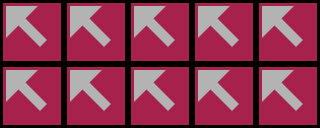A Classic
Today's exercise builds towards reproducing a figure from Abelson and Sussman's seminal text Structure and Interpretation of Computer Programs ("SICP").

This is not the actual figure from that text, but its construction is fundamentally the same.
To test all your functions today, use the following image as your
building block. It is included in the lab 3 starter code. You can
produce it by evaluating (design 64)
Download
lab3-starter.rkt
and open it in DrRacket.
Proceed by writing the functions specified below. In doing so you will
build the skills -- and a toolkit -- to reproduce the figure above.
For this exercise, nothing
in 2htdp/image
is
off-limits. Use scale, beside, above
and whatever else you find apt for the task at hand.
;; quarter : img -> img
The function quarter should consume a square image and
produce one whose side length is half as long. (The image produced has
one quarter the area of the image consumed.)
;; row : num img -> img
The function row should produce a row of n
images. For example, (row 4 (design 64))
;; col : num img -> img
The function col should produce a column of n
images. For example, (col 3 (design 64))
;; grid : num num img -> img
The function grid should produce a grid of images of the
given dimensions. The first argument is the grid width, the second is
the height. For example, (grid 5 2 (design
64))
;; shrinking-row : img -> img
The function shrinking-row should produce a row of images
with the following property: the original image (the one given as an
argument) should be scaled down to 3/4 its original size at every
step. For example, (shrinking-row (design 64))
;; bsr : img -> img
bsr stands for "bidirectional shrinking row" (for lack of
a better name). It's better explained as picture than in
words. (bsr (design 64))
Again, the images are scaled 3/4 at every step.
;; sicp : img -> img
(sicp (design 128)) should produce this:
The pattern is full of self-similarities and mirrorings. Exploit them by writing auxiliary functions to assist in its construction.
There are suggestions for some fun enhancements at the bottom of the starter file. Have a look! (No extra credit.)
Good luck, everyone. As usual, you will be evaluated not only on correctness of your final results, but also on proper documentation, including contracts and purposes for all functions, style (judicious code factoring and no spaghetti code), and ample tests.
Submit
Submit your work via CS151 Handin by 10 PM on Sunday Oct
17. Make sure your work is submitted as Lab3.
Errata
10/14/2010: two edits to fix misstated examples
above. (col 4 ...)(col 3 ...)(sicp
(design 64))(sicp (design
128))



